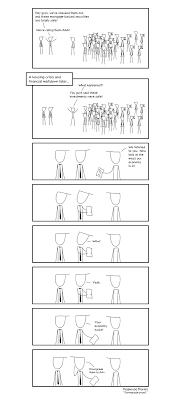Dynamic Hedging by Taleb is one of the most practical books I've gone through around option trading and associated risk management. Without having to explore specifics, Taleb explains logic applied for various derivative trading philosophies going from market making to higher moment trades such as correlation, leptokurtosis betting achieved via option spreads. Here are some of the book's key points I have found practical.
Black Scholes Merton vs. real world option trading
The BSM option pricing model makes a number of false assumptions regarding market behavior:
source: Maxi-Pedia
"
1) Constant volatility. The most significant assumption is that volatility, a measure of how much a stock can be expected to move in the near-term, is a constant over time. While volatility can be relatively constant in very short term, it is never constant in longer term. Some advanced option valuation models substitute Black-Schole's constant volatility with stochastic-process generated estimates.
2) Efficient markets. This assumption of the Black-Scholes model suggests that people cannot consistently predict the direction of the market or an individual stock. The Black-Scholes model assumes stocks move in a manner referred to as a random walk. Random walk means that at any given moment in time, the price of the underlying stock can go up or down with the same probability. The price of a stock in time t+1 is independent from the price in time t.
3) No dividends. Another assumption is that the underlying stock does not pay dividends during the option's life. In the real world, most companies pay dividends to their share holders. The basic Black-Scholes model was later adjusted for dividends, so there is a workaround for this. This assumption relates to the basic Black-Scholes formula. A common way of adjusting the Black-Scholes model for dividends is to subtract the discounted value of a future dividend from the stock price.
4) Interest rates constant and known. The same like with the volatility, interest rates are also assumed to be constant in the Black-Scholes model. The Black-Scholes model uses the risk-free rate to represent this constant and known rate. In the real world, there is no such thing as a risk-free rate, but it is possible to use the U.S. Government Treasury Bills 30-day rate since the U. S. government is deemed to be credible enough. However, these treasury rates can change in times of increased volatility.
5) Lognormally distributed returns. The Black-Scholes model assumes that returns on the underlying stock are normally distributed. This assumption is reasonable in the real world.
6) European-style options. The Black-Scholes model assumes European-style options which can only be exercised on the expiration date. American-style options can be exercised at any time during the life of the option, making american options more valuable due to their greater flexibility.
7) No commissions and transaction costs. The Black-Scholes model assumes that there are no fees for buying and selling options and stocks and no barriers to trading.
8) Liquidity. The Black-Scholes model assumes that markets are perfectly liquid and it is possible to purchase or sell any amount of stock or options or their fractions at any given time.
"
One of the most important lessons from Taleb and Espen Haug, is that one must learn to understand and remedy the weaknesses of applied mathematical models to have a shot at controlling risk and thereby make money.
Fair value estimations
Options on equities, exchange rate futures, and etc. utilize different fair value calculations. It is then intuitive that monitoring real time option price deviations from fair value could offer a robust theoretical edge for the trader.
Arbitrage and Arbitrageurs
Despite an academic belief of "risk-free-ness" of arbitrage means, nothing is in real markets. Taleb discusses risk management around option arbitrage strategies. This main involves liquidity, leverage management, stopping times and etc.
Volatility and Correlation
Taleb discusses several alternative means to estimate historical volatility and correlation for more practical, accurate measurements. Mainly, instead of standard deviations, we could simply look at absolute returns.
Over all, I can't believe it took me so long to get and read this book. It's rare to find a book on quantitative trading that's actually practical in nature, Dynamic Hedging is one of them.





